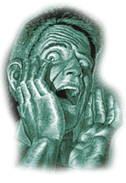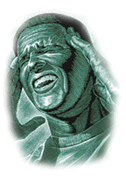|
|
Question: What is the internet? |
|
Answer: The Internet is a LARGE worldwide network of computers. |

Yes, it is a large network with the ability to send and receive files from one computer to another. The three main defining characteristics of the internet are
- interoperable
-
Interoperable means that the standards allow communication across networks. This does not limit
the access of information to a proprietary site, location, machine or brand name.
- packet switched
- Connections are not FIXED from point to point for the duration of the transmission. A telephone
call is circuit switched - which means a dedicated path is established to transmit your
entire conversation. When data is sent packet switched over the internet - it transmits a small part of the data,
verifies it is correct, then sends more information toward the destination. Packet switched networks
do not require all of the information to be delivered through the same path. By not dedicating the
path for the duration of the connection, this method allows more connections to be sending information
across the same space or allows for sharing resources.
- data network
- A network that carries data information (digital - computer) instead of voice
information (analog - telephone). There are many instances where these "definitions"
of data and voice are starting to overlap. Computers connecting to regular phone lines
are technically carrying data over a voice line
and in some progressive parts of the country digital phone lines are starting to make appearances.
- e-mail Send Jim some e-mail
- E-mail is electronic mail. It is sent over the internet electronically instead of over
the roads via the US Postal Service. It delivers a message almost instantaneously to
anyone in the world. The messages go into electronic mailboxes for users to read at their convenience
- FTP shareware AOL
- File Transfer Protocol (FTP) is a method of transferring files to or
from another computer.
Whenever you hear of someone talking about downloading or uploading they
are talking about FTP.
- www INTEK home page
- The world Wide Web (WWW or W3 or Web) has become a world wide phenomena. Where other
applications rely on your knowledge of Internet addressing, hierarchical
directory structures, and
the application's own variations of command elements, web applications let you navigate by
clicking on words or pictures. These hot links are established through hypertext. Often confused
with the internet - in reality, the WWW is only one of many parts of the internet.
- gopher
Webopedia
- Gopher was the first internet application that used a menu driven approach to navigation.
Gopher lacked the graphic and other media rich components of the WWW that we enjoy today.
Today, many sites that contain large bodies of text are still available through this method.
- Usenet Public News
Servers
- Newsgroups (currently over 50,000) started when a few individuals at a few campuses wanted
to share information with postings that anyone could access and read. "Legend has it that way back
then (about 10 years ago) you could read every message in every group over a (single) cup of coffee.
Do be aware that if you start reading and participating to these groups, anyone in the world
has access to messages that you post to a newsgroup.
- telnet list of Free-Nets
- Telnet is a program that allow you to remotely connect to and use a computer somewhere else.

When did this all start? The main backbone of the network in the United States is the National Research and Education Network (NREN), a product of the High Performance Computing Act of 1991, pushed through congress by then-Senator Al Gore. It was designed to help the K12 and college communities become part of the Internet more easily.
Question:How many computers are hooked up to the internet today?- Answer:
The number of hosts (or individual computers) is currently 45 million.
Source:MacMillian, January 1999
Question: Where is it all headed?- Answer: NUA, one of Europe's leading
online consultants and developers, estimates the number of Internet users world wide
to be 100.5 million. By the year 2000, analysts predict that number will jump to
200 million. Source: NUA, January 1998 Several different analysts agree that
the numbers will approach 200 million by the year 2000.
Question: Why is the internet such a big deal?- Answer: The internet is a powerful communications tool.
In and of itself, it is no more than a bunch of wires and computer, but
it empowers its users with instantaneous access to data, tools and the
power to accomplish
many different tasks.
28094

Back to Internet 101